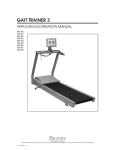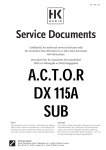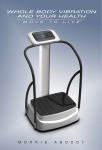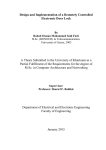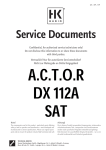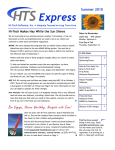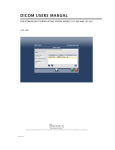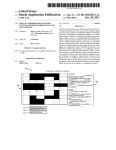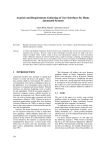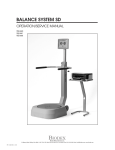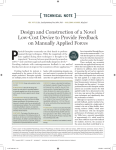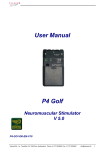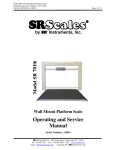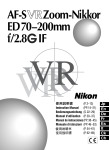Download RTM 600 REHABILITATION TREADMILL BIODEX
Transcript
RTM 600 REHABILITATION TREADMILL APPLICATION/OPERATION MANUAL 950-420 950-421 950-422 950-423 950-426 950-427 BIODEX Biodex Medical Systems, Inc. 20 Ramsey Road, Shirley, New York, 11967-4704, Tel: 800-224-6339 (Int’l 631-924-9000), Fax: 631-924-9338, Email: [email protected], www.biodex.com FN: 11-086 Rev B 8/14 RTM 600 This manual covers installation and operation procedures for the following products: 950-420 950-421 950-422 950-423 950-426 950-427 Treadmill, Treadmill, Treadmill, Treadmill, Treadmill, Treadmill, RTM600, RTM600, RTM600, RTM600, RTM600, RTM600, 115 VAC 230 VAC 115 VAC, with Extended Handrails 230 VAC, with Extended Handrails 115 VAC, with Geriatric/Pediatric Handrails 230 VAC, with Geriatric/Pediatric Handrails NOTE: All or some of the following symbols, cautions, warnings and notes may apply to your Gait Trainer 2 and correspond to this operation manual: Symbol Meaning ! DANGER: will result in an imminently hazardous situation if not avoided. ! WARNING: will result in a potentially hazardous situation if not avoided. ! CAUTION: may result in a potentially hazardous situation if not avoided. ! ATTENTION: consult accompanying documents. Symbol Signification ! DANGER : aura comme conséquence une situation d'une manière imminente dangereuse sinon évitée. ! AVERTISSEMENT : aura comme conséquence une situation potentiellement dangereuse sinon évitée. ! ATTENTION : peut avoir comme conséquence une situation potentiellement dangereuse sinon évitée. ! ATTENTION : consultez les documents d'accompagnement. CAUTION: Federal law restricts this device to sale by or on the order of a medical practitioner. When prescribed for therapeutic purpose, a physician should clearly define the parameters of use (i.e., total work, maximum heart rate, etc.) to reduce the risk of patient injury. — II — TABLE OF CONTENTS 1. IntroductIon ..........................................................................................................................1-1 2. safety consIderatIons for General use ..............................................................2-1 3. setup ................................................................................................................................................3-1 • Connecting the Safety Lanyard ..................................................................................................3 1 • Handrail Installation (Optional) ................................................................................................3-2 4. QuIck start operatIon ......................................................................................................4-1 • Quick Start Track/Numeric Display Parameters ....................................................................4-1 5. Manual operatIon ................................................................................................................5-1 • Manual Operation ........................................................................................................................5-1 • Manual Mode Exercise Track/Numeric Display Parameters ................................................5-2 6. profIle operatIon..................................................................................................................6-1 • Choosing a Pre-Defined Exercise Profile ..................................................................................6-1 • Designing a Custom Exercise Profile ........................................................................................6-3 7. rtM 600 utIlItIes ......................................................................................................................7-1 • Configuration ................................................................................................................................7-1 • System Maintenance ....................................................................................................................7-3 • Speed and Elevation Calibration ................................................................................................7-3 8. MaIntenance ............................................................................................................................8-1 • Daily Maintenance ........................................................................................................................8-1 • Quarterly Maintenance ................................................................................................................8-1 • Annually or Every 1,000 Hours ..................................................................................................8-1 • Maintenance Procedures ..............................................................................................................8-2 9. troubleshootInG ..................................................................................................................9-1 10. electroMaGnetIc coMpatabIlIty ............................................................................10-1 11 specIfIcatIons ........................................................................................................................11-1 12 references and bIblIoGraphy ....................................................................................12-1 13 asseMbly drawInGs and scheMatIcs ....................................................................13-1 — III — CONTENTS 1. INTRODUCTION The RTM 600 is the only treadmill to offer a true zero starting speed, 1/10 mph speed increments over a range of 0-10 mph, plus powered incline and decline in both forward and reverse directions. Extremely versatile, it’s perfect for exercise with acute post-operative, neuro, pediatric, cardiopulmonary, respiratory, seniors and orthopedic/sports medicine patients in need of strengthening and aerobic conditioning. Biodex, the leader in motor control technology for medical applications, uses the same Four Quadrant Pulse Width Modulation (PWM) technology for the Biodex RTM 600 as is used in the world-famous Biodex Dynamometer. With more power and consistent speed control than conventional AC or DC motors, the RTM 600 can operate at the slowest speeds, regardless of weight strain. This advantage proves especially beneficial when treating larger patients in the earliest phases. The spacious 20" x 64" (50.8 x 160 cm) low profile, Teflon-impregnated running deck has a low step-up and incorporates a shock-absorbing surface to reduce stress and trauma to the lower back and extremities. Add in our Exact-Track belt, which eliminates tracking problems, and it’s easy to see why patients who might not be able to tolerate other treadmills can get a head start on the RTM 600. The RTM 600 is also the only treadmill that allows retro-walking exercise while facing forward for more effective proprioception training in a safe environment. Retro-walking promotes extension of the knee and dorsiflexion of the foot, which at the same time uses eccentric control of the hamstrings to actively decelerate the joint. Ideal for training patients to negotiate handicap ramps Unusually quiet and easy to operate, the RTM 600 features an intuitive Touch Screen LCD Graphic Display that provides both pre-defined and user-defined programmability, quick start and manual modes. Heart rate monitoring is accomplished using contact heart rate handgrips. The system comes with a sturdy support bar, but optional Extended and Geriatric/Pediatric Handrails are also available. The treadmill can be configured for either 0 to 15% or -3 to 12% incline. — 1-1 — INTRODUCTION ! 2. SAFETY CONSIDERATIONS FOR GENERAL USE The following safety considerations should be observed for all patients who exercise on the RTM 600. 1. 2. 3. 4. 5. All patients should consult a physician before beginning any rehabilitation program. Instruct patient on proper use and all RTM 600 safety features before beginning exercise. Always attach the Safety Lanyard to the patient’s clothing or wrist before allowing exercise to begin. Ensure patient has stretched and warmed-up prior to starting exercise. Do not allow any patient to exercise unattended on the RTM 600. Never leave the RTM 600 running unattended. 6. Periodically monitor the heart rate of patients exercising on the RTM 600. 7. Begin all exercise at a slow pace, increasing speed gradually to patient tolerance and progressing toward exercise goals. Always inform the patient immediately prior to increasing or decreasing speed or elevation. 8. If reversing belt direction, bring the RTM 600 to a complete stop and inform patient that the belt will begin moving in the opposite direction. 9. Immediately discontinue exercise if patient feels faint, dizzy or short of breath. 10. Never allow anyone to step onto the RTM 600 while the treadbelt is in motion. Always stop the RTM 600 prior to allowing the patient to step up onto the treadbelt. 11. Instruct patients to use the handrails when first learning to walk on the RTM 600. On devrait observer les considérations suivantes de sûreté pour tous les patients qui s'exercent sur le RTM 600. 1. 2. 3. Tous les patients doivent voir leur médecin responsable avant d’entreprendre la séance de rééducation. Expliquer au patient la bonne utilisation des systémes de sécurité du tapis avant de démarrer la séance. Connector toujours la sangle de sécurité aux vêtements du patient ou poignet avant que le patient ne commence à travailler. 4. Vérifier que la patient s’est échauffé et a fait des étirements avant de commencer l’entraînement sur le tapis. 5. Ne pas laisser le patient seul sur le tapis pendant la séance. Ne jamais laisser le tapis tourner sans patient et sans surveillance. 6. Surveiller de temps à autre la fréquence cardiaque du patient pendant la séance. 7. Démarrer les protocloes à une vitesse lente et augmenter progressivement la vitesse en fonction de la tolérance du patient et progres uers les objectifs de la séance. Signaler avant de l’appliquer tonte augmentation ou diminution de vitesse ou d’inclinaison. 8. Avant de changer la direction de déplacement du tapis, arrêter le tapis complétement et expliquer au patient que le tapis va démarrer dans le sens opposé. 9. Arrêter la séance immédiatement en cas de dyspnée, d’étourdissements ou d’autres signes de malaise. 10. Ne jamais faire monter personne sur le tapis pendant que le tapis est en marche. Arrêter toujours le tapis avant que le patient ne s’y positionne. 11. Donner la consigne au patient d’utiliser les barres horizontales lors de sa premiére séance sur le tapis. — 2-1 — CLINICAL CONSIDERATIONS FOR GENERAL USE 3. SET-UP Attach Safety Lanyard Figure 3.1. Attaching the Safety Lanyard. Included with the RTM 600 is a Safety Lanyard that must be attached prior to operation. connectInG the safety lanyard (See Figure 3.1.) A Safety Lanyard is provided. The RTM 600 will not operate unless the lanyard is attached. Attach the Safety Lanyard at the left corner of the top cross bar supporting the Display panel. The round end of the Safety Lanyard attaches to the unit via a Velcro® brand hook and loop fastener. The clip end of the lanyard should be attached to the patient’s clothing or wrist in a way that does not interfere with the patient’s exercise. NOTE: Disconnecting the Safety Lanyard (left side of Display/Control Panel) or pressing the red Safety Stop (atop the right side of the Support Bar) at any time will cause the treadbelt to immediately ramp down to a full stop and reset to 0.0 mph. The Display will read <Safety Lanyard Removed> and the treadbelt will not restart until the Safety Lanyard is once again in position or <Start> is pressed following use of the Safety Stop. Display data is not lost in either case. Data accumulation will resume once the lanyard is reconnected and/or <Start> has been pressed. — 3-1 — SET-UP CONTENTS handraIl InstallatIon (optIonal) (See Figures 3.2 – 3.4.) Figure 3.2. Figure 3.3. Figure 3.4. The Biodex RTM 600 comes with a sturdy support bar installed (Figure 3.2). Optional Extended (Figure 3.3) and Geriatric/Pediatric handrails (Figure 3.4) are also available. SET-UP — 3-2 — CONTENTS The Biodex RTM 600 comes with a sturdy support bar, but optional Extended and Geriatric/Pediatric handrails are also available. Both optional handrails are installed as follows: NOTE: Do not fully tighten any screws until all the screws and hardware have been positioned and partially secured. 1. 2. 3. 4. 5. 6. 7. 8. Using a Phillips screwdriver, remove the two screws that attach the cover plate to side of the display support bar. Set the screws and mounting plates aside. Using a 9/16-inch box wrench, attach the optional handrail to the display support bar with a 3/8-inch lock washer and hex head bolt. Slide the handrail mounting bar into the bottom of the optional handrail so that the screw holes align. Attach the bottom of the handrail to the platform deck frame using two 1/4 - 20 x 1.75-inch socket-head screws. Using one 1/4 - 20 x 1.75-inch button-head screw, secure the optional handrail to the support bar. Pass the screw, threads to the outside of the deck, through the support bar first and into the optional handrail. Tighten all screws. Using a Phillips screwdriver, replace the cover plate on the display support bar with the two screws set aside in step #1. Repeat the procedure to attach the opposite optional handrail. — 3-3 — SET-UP 4. QUICK START OPERATION Figure 4.1. The Quick Start feature allows the user to begin the exercise session with minimal input. QuIck start operatIon (See Figure 4.1.) Although the RTM 600 offers advanced programming capability, it also features a "Quick Start" function that allows the user to immediately begin exercise on the system with 1/4-mile scaled track views. Quick-Start operation is simple. With the system turned ON, position the user on the treadbelt and proceed as follows: 1. Touch Display. The Opening Menu should now be displayed. 2. Touch <Quick Start>. The Quick Start Exercise Track should now be displayed. (See Figure 4.1) 3. Press <Start> on the display to activate the treadbelt. The treadbelt will ramp up to .01 mph. 4. Touch the <▲> and <▼> arrows on the screen to adjust <Speed> and <Elevation> as desired. 5. Touch the display icons at the bottom left of the screen to toggle between the Quick Start Exercise Track display and a Numeric display. 6. Touch <Pause> to pause the exercise session at any time. Touch <Resume> to resume the exercise session. 7. Touch <End> to end the exercise session at any time. 8. Touch <Reset> to return to the Opening screen. — 4-1 — QUICK START OPERATION CONTENTS QuIck start track / nuMerIc dIsplay paraMeters Users can choose from a Quick Start Exercise Track or Numeric display during Quick Start exercise sessions. The following parameters are displayed for both choices. NOTE: To toggle between displayed parameters (i.e., to change measurement units for calories, pace or distance) touch the yellow dot next to each parameter heading. Time: Cumulative time in minutes/seconds from the point at which the treadbelt begins to move in either direction. Distance: The distance covered in miles or KM from the beginning to the end of the current exercise session. Calories: Toggle between: • Calories: Total calories burned by the user during the current exercise session. This value is displayed in real-time. • Calories/Hr: Total calories that will be burned in one hour if exercise continues at the current rate. This parameter is dependent upon a default weight of 150 pounds. • METs: This value reflects the resting rate of Oxygen consumption with one MET equal to the Oxygen consumption of a seated individual at rest. Thus, a seated individual in a resting state is consuming one MET. A seated individual exercising at a rate of two METs is consuming twice the Oxygen of a seated, resting individual. A person exercising at 10 METs is consuming ten times the Oxygen of a seated, resting individual. To compute the METs of a person actively exercising on the Gait Trainer 2, the system uses standard calculations based on American College of Sports Medicine Guidelines for Testing and Exercise. The METs value is always displayed in real/time for current speed. Pace: The amount of time it will take the user to move one mile or KM at the current treadbelt speed. Heart Rate: This is the real-time heart rate of the user during the exercise session measured using the contact handgrips. QUICK START OPERATION — 4-2 — 5. MANUAL OPERATION Figure 5.1. The RTM 600 Setup Options screen allows entry of patient-specific information and parameters. Manual operatIon (See Figure 5.1.) Manual Operation is easy with the Biodex 600 RTM. Like the Quick Start function, Manual Start allows the user to begin exercising quickly. Rather than use default settings, however, this mode of operation prompts the clinician to enter the patient’s body weight, select the treadbelt direction, and enter values for Time, Distance and Calories. During the exercise, the user can choose between Exercise Track or Numeric displays. Manual operation procedure NOTE: For all screens, <Next> advances to the next screen, <Back> returns the user to the previous screen. 1. At the RTM 600 Opening Menu select <Manual Start>. The Setup Options screen should now be displayed. 2. At the Setup Options screen, touch the appropriate icons to enter information and select treadbelt direction. In addition to the <▲> and <▼> arrows, a pop-up keypad can be used to enter values for Distance, Calories and Body Weight. Once the desired information is entered/selected, touch <Next> to advance to the Exercise Track display. 3. At this point, you can touch the Display icons at the lower left of the screen to toggle between the Exercise Track display and a Numeric display. 4. With the Exercise Track or Numeric Display on the screen, simply touch the yellow dot next to any heading or icon if you want to change the value. To toggle between value settings (i.e., miles/KM) touch the displayed parameter. — 5-1 — MANUAL OPERATION CONTENTS 5. When all parameters are entered/selected, press <Start> on the display to activate the treadbelt and begin the exercise session. The treadbelt will ramp up to .1 mph. 6. Use the <▲> and <▼> arrows on the Exercise Track or Numeric Display to adjust the speed setting to the desired value. Both speed and elevation can be adjusted at any time during the exercise session. 7. Touch <Pause> to pause the exercise session at any time. Press <Resume> to resume the exercise session. 8. Touch <End> to end the exercise session at any time. 9. Touch <Reset> to return to the Opening screen. Manual Mode eXercIse track and nuMerIc dIsplay paraMeters (See Figures 5.2 and 5.3.) The same parameters are displayed on both the Exercise Track and Numeric displays. A brief explanation of these parameters follows. Time: Counts down in minutes and seconds the total time entered for the exercise on the Setup Options screen. Distance: Displays the distance in miles or kilometers that the patient is expected to complete in the exercise session. Calories: Toggle between: • Calories: Total calories burned by the user during the exercise session. • Calories/Hr: Calories that will be burned per hour at the current pace. • METs: This value reflects the resting rate of Oxygen consumption with one MET equal to the Oxygen consumption of a seated individual at rest. Thus, a seated individual in a resting state is consuming one MET. A seated individual exercising at a rate of two METs is consuming twice the Oxygen of a seated, resting individual. A person exercising at 10 METs is consuming ten times the Oxygen of a seated, resting individual. To compute the METs of a person actively exercising on the Gait Trainer 2, the system uses standard calculations based on American College of Sports Medicine Guidelines for Testing and Exercise. The METs value is always displayed in real/time for current speed. Select Direction: Use the <Forward> and <Reverse> icons to select the desired treadbelt direction. Pace: The amount of time it will take the user to move one mile or KM at the current treadbelt speed. MANUAL OPERATION — 5-2 — CONTENTS Figure 5.2. The Exercise Track display. Figure 5.3. The Numeric display. — 5-3 — MANUAL OPERATION 6. PROFILE OPERATION The Biodex RTM 600 comes with five pre-loaded exercise profiles and the ability to create and select up to 12 custom exercise profiles. These programs allow the clinician to select pre-determined exercise format routines. Exercise profiles are divided into as many as ten segments each. Users can select any of the pre-defined exercise profiles, review or edit any exercise profile, or delete an existing exercise profile. The pre-defined exercise profiles include: • Anerobic • Aerobic • Pyrimiding • Surge • Random choosInG a pre-defIned eXercIse profIle (See Figures 6.1, 6.2 and 6.3.) To choose a pre-defined exercise profile: 1. At the RTM 600 Opening Menu touch <Profile>. The Select Profile screen should now be displayed 2. Touch to select the desired pre-defined exercise profile. The Profile Setup Options screen should now be displayed. 3. At the Profile Setup Options screen, enter the Time duration, user’s body weight, and the maximum elevation for the exercise profile. Touch <Next> to advance to the Profile Exercise screen. 4. At the Profile Exercise screen, push <Start> on the display to activate the treadbelt and begin the exercise session. The treadmill will also automatically rise or lower to the required elevation. 5. The RTM 600 will automatically beep to signal the end of each profile segment and elevation for the next segment. If necessary, the <▲> and <▼> arrows on the Exercise Track or Numeric Display can be used to adjust the speed and elevation setting at any time. 6. Touch <Pause> to pause the exercise session at any time. Press <Resume> to resume the exercise session. 7. Touch <End> to end the exercise session at any time. 8. Touch <Reset> to return to the Opening screen. 9. Touch <Reset> to return to the Opening screen. — 6-1 — PROFILE OPERATION CONTENTS Figure 6.1. The Select Profile screen allows the user to choose from five pre-defined profiles. Figure 6.2. At the Profile Setup Options screen, users can enter values for time, body weight and maximum elevation. PROFILE OPERATION — 6-2 — CONTENTS Figure 6.3. Ready to begin an exercise session with Profile 1, Anaerobic, selected. desIGnInG a custoM eXercIse profIle (See Figure 6.4.) To design a custom exercise profile: 1. At the RTM 600 Opening Menu touch <Profile>. The Select Profile Menu should now be displayed 2. Touch option six, <Custom>. The Custom Profiles screen should now be displayed. 3. Touch <Edit Profile> and then enter the number (1 – 12) of the profile you would like to design. Touch <OK>. The Editing Profile screen should now be displayed with the number of the profile you have decided to design. 4. Each exercise profile can be divided into as many as ten separate stages. Enter the speed, elevation and time duration for each stage. If you make a mistake and need to clear the stages, touch <Clear Stages>. Touch <OK> to return to the Custom Profile menu. 5. At this point, you can touch to select any of the custom profiles designed. The Custom Profile Setup Options screen should now be displayed. Proceed as if using a pre-defined profile. — 6-3 — PROFILE OPERATION CONTENTS Figure 6.4. At the Editing Profile screen, clinicians enter values for speed, elevation and time for each of up to ten stages for any profile. PROFILE OPERATION — 6-4 — 7. RTM 600 UTILITIES Figure 7.1. The Utilities Menu allows access to the Configuration screen. The System Maintenance screen, not displayed, is also accessed through the Utilities Menu. The Utilities Menu allows users to access the Configuration and System Maintenance (not shown) screens. The Utilities Menu also displays technical information about the RTM 600, firmware version, and cumulative hours of use. To access the Utilities Menu, touch <Utilities> on the Main. The Utilities Menu should now be displayed. confIGuratIon (See Figures 7.2 and 7.3.) Figure 7.2. The Configuration screen. — 7-1 — RTM 600 UTILITIES CONTENTS To advance to the Configuration screen from the Utilities Menu, touch <Configuration>. Enter 781 at the “Access ID Code” prompt and touch <OK>. The Configuration screen should now be displayed. This screen allows the user to choose between various display options and to set specific parameters for a variety of treadmill functions. Following is a description of Configuration screen options. Once all parameters and values are set as desired, touch <Back> to exit and return to the Utilities Menu. Touch <Back> again to return to the Main Menu. configuration screen parameters Figure 7.3. The Set Test/Exercise Complete Screen Time Out screen. Set Screen Time Out: Touch this option to advance to the Set Test/Exercise Complete Time Out Screen. This setting determines how long the Exercise Results screen will be displayed before the screen saver kicks in following completion the exercise session. Default is 1:00 minute but the range can be adjusted from 0:00 to 30:00 minutes. Touch the <▲>or <▼> icons to increase or decrease the value. Touch <OK> to continue and return to the Configuration screen. Screen Saver: The setting determines how long the display screen remains ON when the system is no longer in use. Once the selected time expires, the screen fades to black even if the system remains ON. 1. At the Configuration Screen, touch <Screen Saver>. 2. Use the < ▲> or < ▼> arrows to increase or decrease the value displayed in 1 minute increments. The Time Out range is from 00:00 to 60:00. 3. Touch <OK> to confirm your changes and return to the Configuration screen. Touch <Cancel> to return to the Configuration screen without making any changes. Set Date/Time: Touch <Set Date/Time> to change the system time or date. Touch to highlight the value to change, then use the <▲>or <▲> icons to increase or decrease the value as desired. Touch <OK> to return continue and return to the Configuration screen. RTM 600 UTILITIES — 7-2 — CONTENTS LCD Brightness: Touch any section of the horizontal bar to select a new brightness setting. Selecting low numbers along the bar will result in a darker screen while selecting high numbers makes the screen appear brighter. Brightness levels range from 1 to 15. Tone Volume: Touch any section of the horizontal bar to select a new tone volume setting. Selecting low numbers along the bar will result in lower volume while selecting high numbers makes the louder. Tone volume settings range from 0 to 10. treadmill settings Figure 7.4. The Treadmill Settings screen. • Zero Balance: This feature is used to eliminate treadbelt “creep” (slow movement of the treadbelt while the speed is set to zero.) Select negative values to zero out forward treadbelt creep and positive values to zero out reverse belt creep. Note: Belt Movement While at Zero Speed Inherent "belt creep" is common with Pulse Width Modulation Motor Control. Allow the treadmill sufficient time to "warm up" prior to making any adjustments for belt creep. • Incline Range: The RTM 600 comes with a choice of 0 to 15 or –3 to 12 degrees of incline. Touch the displayed value to show both options and then touch the desired setting to select. • Measure Units: The RTM 600 can be configured to display either U.S. or metric measurements. To change units, touch the displayed units and then touch the desired setting to select. • Access Protection for Custom Profiles: Access protection requires entry of an I.D. code (781) to access custom profiles. Touch the displayed value to show both options, then touch the desired setting to select. — 7-3 — RTM 600 UTILITIES 8. MAINTENANCE Your Biodex RTM 600 should provide trouble-free operation as long as the following maintenance procedures are performed. To verify hours of operation, simply touch <Utilities> button (see Figure 8.1). At the bottom of screen, hours of use will be indicated (see Figure 8.2). Be sure to adhere to the hours of usage guidelines in Figure 8.3. Be sure to adhere to the hours of usage guidelines in the chart below. NOTE: Without proper maintenance, excessive wear to drive components will occur. To assure trouble-free operation, scheduled maintenance must be performed. Failure to adhere to the scheduled maintenance chart below will void your warranty. ! ! WARNING: Only qualified persons should perform maintenance and repair on this device. This is a motorized device with many moving assemblies. Precaution is necessary. AVERTISSEMENT: Seulement les personnes qualifiées devraient exécuter l'entretien et la réparation sur ce dispositif. C'est un dispositif motorisé avec beaucoup d'assemblées mobiles. La précaution est nécessaire. Figure 8.1. Main Menu, depicting <Utilities> button. — 8-1 — MAINTENANCE CONTENTS Figure 8.2. Utilities Screen, depicting hours of use. Instruction hours of usage Lubricate Deck Reverse Deck Belt Replacement Clean Motor and Amp Front Roller Cleaning 75 1,000 1,000 750 375 Figure 8.3. Hours of Usage Guidelines daIly MaIntenance As required, clean all exterior surfaces, upholstery and restraining straps. Specialized vinyl cleaners or protectants are recommended for upholstery and cushions. Otherwise, use a solution of warm water and mild detergent. NOTE: DO NOT use solutions containing ammonia. Hardware computer components should be wiped clean as needed using a soft rag dampened with alcohol. Quarterly MaIntenance lubricate treadbelt and slider deck The Biodex Lubricant Kit is designed to reduce friction between the treadbelt and the slider deck. It is required for all institutional treadmills. Proper and timely application of the lubricant will prevent premature failures due to excessive wear and load. Items affected by inadequate lubrication are the treadbelt, slider deck, motor, and motor controller. MAINTENANCE — 8-2 — CONTENTS annually or eVery 1,000 hours reverse exact-track bed Reverse the Exact-Track bed. The RTM 600 bed is double-sided, allowing it to be reversed and used over. Once both sides have been used, the bed must be replaced. replace treadbelt Inspect Treadbelt for cracks or tears. If none are found, continue to use. If any cracks or tears are apparent, replace treadbelt. MaIntenance procedures belt/deck lubrication (See Figure 8.4.) 1. 2. 3. Using the large syringe provided, squirt one-half tube of the lubricant underneath the center of the treadbelt. Walk 10 steps on the RTM 600 at a speed of 1.0 mph. This will moisten an 8” track underneath the center of the entire treadbelt. Allow the RTM 600 to dry for approximately 10 minutes. NOTE: Use only the Biodex lubricant kit with your RTM 600. Most standard greases, waxes and silicon sprays will build up on the rollers, causing belt slippage and affecting tracking. To re-order lubricant kit, use Biodex part # 945-276. Each container provides 12 applications. Figure 8.4. Squirt one-half tube of lubricant between the belt and deck. — 8-3 — MAINTENANCE CONTENTS reverse or replace treadbelt and deck Tools Required: Phillips Screwdriver, 9/16 Socket, 3/16 and 5/32 Allen Wrench Elevate treadmill to 10 degrees, allowing access to the underside of the RTM 600. Remove power cord from wall outlet. Remove motor cover secured by the six Phillips head screws. Once screws are removed, lift and remove cover. Remove motor tension lock nut, located on the underside of accessory pan. The nut is attached to the motor bracket tensioning bolt. Once the tensioning bolt has been removed, lift the motor up and remove motor drive belt. Remove the two aluminum traction strips, located one on each side of running deck. These are secured by four Allen screws located on top of traction strips. Remove rear treadbelt roller. The roller is secured by two treadbelt tensioning bolts. Once bolts have been removed, lift out the roller assembly. Remove the two Allen screws which secure the front treadbelt roller. The screws are located on the side of the RTM 600. 1. 2. 3. 4. 5. 6. 7. ! CAUTION: When the bolts securing the roller are removed the roller will drop. Be aware that the rollers are heavy. ! ATTENTION: Si les boutons de sécurité du rouleau sont retirés, le rouleau chutera. Ne oas oublier que les rouleaux sont lourds. 8. Remove the running deck. This is done by lifting from the side of the deck and raising the deck two inches before sliding it out. The running deck is two-sided and can be flipped over and reused once. 9. To remove the treadbelt seven support brackets must be removed. These are comprised of three angle iron brackets attached by securing nuts, and four running deck support bars secured by Allen screws. Once all support brackets are removed the treadbelt can be removed. 10. Tension treadbelt and adjust tracking after you reassemble the RTM 600. (See Treadbelt Adjustment procedure.) treadbelt adjustment Although the RTM 600 incorporates the “Exact Track System,” occasional belt adjustments are still necessary for correct tensioning and tracking. tension adjustment CAUTION: Before testing treadbelt tension as described below, turn the RTM 600 OFF and unplug the system. Moving parts on the RTM 600 can cause serious injury. Do not attempt to determine treadbelt tension while the belt is moving. ! ! ATTENTION: Avant de tester la tension du tapis selon la procédure décrite ci-dessons, méttre le tapis à l’arrêt et déconnecter le câble secteur. Certaines piéces du tapis peuvent entrainer des blessures graves. Ne jamais essayer de déterminer la tension sur le tapis pendant que ce dernier est en mouvement. MAINTENANCE — 8-4 — CONTENTS The need for tension adjustment is indicated by uneven belt speed or the belt stopping suddenly upon foot impact. Properly tensioned, the treadbelt will allow the user to slip a hand snugly under the center of the belt. Treadbelt tension is adjusted by tightening or loosening the two hex-head, 9/16, bolts at the end of the RTM 600 frame. The bolts should be adjusted in 1/4-turn increments, exactly the same amount, in the same direction. Turn both bolts clockwise to tighten the belt. Turn both bolts counterclockwise to loosen the belt. Failure to turn both bolts equally may affect tracking. One quick test is to apply hand heel strikes and observe if belt momentarily stops. If belt speed remains constant, this indicates belt is tight. If belt hesitates during heel strikes, additional tightening is required. To check over tightening, set RTM 600 to .5 mph and, while holding rail, resist until belt stops. If drive roller continues to rotate with the belt stopped, further adjustment is not necessary. If drive roller stops when belt is stopped, belt is too tight. Loosen belt and recheck. tracking Tracking adjustment is necessary when a pronounced bump appears toward the left side of the belt, approximately two inches from the left edge. This occurs when the belt works its way out of the Exact-Track grooves. To Adjust Treadbelt Tracking: Tighten the hex tensioning bolt on the side to which the treadbelt has migrated, turn bolt in 1/8 increments clockwise. The tread belt should slowly move away from the tightened bolt. Once belt migrates back into roller slot the bump will disappear. At this point, fine tracking adjustment is necessary. fine tracking Fine tracking adjustment prevents premature wear of the tacking belt rib which rides in the ExactTrack groove. The belt rib should be centered in the tracking groove. If the rib rides against the groove wall, a friction point forms causing excessive wear. This adjustment should be made during preventative maintenance or during belt replacements. To Adjust Fine Tracking: Determine which side of the exact track groove the belt rib is riding on. Mark treadbelt tracking position on deck. Tighten the hex tensioning bolt on the side the belt is tracking against, belt should migrate to the opposite side of the groove. Mark the treadbelt tracking position on the deck. You now have two marks on the deck 1/4” apart. Mark the center position of the marks. This is where the belt should track. Adjust 9/16 tensioning bolt so that the belt is centered on the mark. Remember the belt will migrate away from the tension bolt that is adjusted last. Tracking adjustments are done in forward direction only, at 8 mph. Check tensioning after adjustment to ensure proper belt performance and wear. NOTE: Motor drive belt should never slip. Check this when you check for treadbelt overtightening. If treadbelt drive roller is stopped, motor should also stall. If motor turns, but drive roller is stopped, tighten motor tension bracket located under the mill. Adjust until the motor belt stops slipping. — 8-5 — MAINTENANCE syMptoM RTM 600 is turned ON and speed control is inoperable (belt not moving). Check for faults on display. The following diagnostic error codes apply: NOTE: The above faults indicate an issue with your treadmill. For fault 64-Safety Lanyard Removed, verify lanyard is still attached in its proper location. For all other faults, please contact Biodex Support Services department and provide the fault code. You will be instructed on how to proceed. 1-800-224-6339. 9. TROUBLESHOOTING CODE DESCRIPTION 128 Communication between upper/lower board inop 64 Safety Lanyard Removed 32 Control fault (no amplifier) 16 Grade Error 8 Motor Tach Output Exceeds Selected Speed 4 Motor Tach Output is Below Selected Speed — 9-1 — TROUBLESHOOTING 10. ELECTROMAGNETIC COMPATABILITY conformance to standards This equipment conforms to the following safety standards: standard edition and/or date IEC60601-1-2 First edition, 2007 Table 1.1 Safety standards accompanying eMc documents This medical electrical equipment needs special precautions regarding EMC and needs to be installed and put into service according to the EMC information provided in this manual. • Portable and mobile RF communications equipment can affect medical electrical equipment. • Use of accessories, transducers and cables other than those specified, with the ex¬ception of accessories, transducers and cables sold by the manufacturer of this equipment, as replacement parts for internal and external components, may result in increased emissions or decreased immunity of the equipment. • The Gait Trainer III Treadmill should not be used adjacent to or stacked with other equipment. If the Gait Trainer III Treadmill is used while positioned adjacent to other equipment, it should be observed to verify normal operation in the configuration in which it will be used. list of cable accessories The list in Table 1.2 includes all accessory cables supplied with the Gait Trainer III Treadmill for which the manufacturer of this equipment claims compliance to EN 60601-1-2 when used with the Gait Trainer III Treadmill. cable description part no. cable length USB Printer Cable Biodex # C12086 15ft Table 1.2 Gait Trainer III Treadmill cable — 10-1 — ELECTROMAGNETIC COMPATIBILITY CONTENTS declaration of conformity emissions Manufacturer’s declaration electromagnetic emissions The Gait Trainer III Treadmill is intended for use in the electromagnetic environment specified below. The customer or the user of the Gait Trainer III Treadmill should assure that it is used in such an environment emission test compliance electromagnetic environment RF emissions CISPR 11 Group 1 The Gait Trainer III Treadmill generates RF energy only for its internal functions. Therefore, its RF emission is very low and is not likely to cause any interference in nearby electronic equipment RF emissions CISPR 11 Class A The Gait Trainer III Treadmill is suitable for use in all establishments other than domestic and those directly connected to the public low-voltage power supply network supplying buildings used for domestic purposes. Harmonic distortion EN 61000-3-2 Class A Voltage fluctuations and flickerEN 61000-3-3 Complies Immunity Manufacturer’s declaration electromagnetic immunity The Gait Trainer III Treadmill is intended for use in the electromagnetic environment specified below. The customer or the user of the Gait Trainer III Treadmill should assure that it is used in such an environment. Immunity test Iec 60601-1-2 Iec 60601-1-2 electromagnetic test level compliance level environment – guidance Electrostatic discharge (ESD) IEC 61000-4-2 ± 6 kV contact ± 8 kV air Contact ± 6 kV Air ± 8 kV Floor should be wood, concrete or ceramic tiles. If floor is covered with synthetic material, the relative humidity should be at least 30% Electrical fast transients/burst IEC 61000-4-4 ± 2 kV for power lines ± 1 kV for input/output lines Power ± 2 kV Signal ± 1 kV Mains power quality should be that of a typical commercial or hospital environment Surge IEC 61000-4-5 ± 1 kV differential mode ± 2 kV common mode ± 1 kV diff. mode ± 2 kV com. mode Mains power quality should be that of a typical commercial or hospital environment ELECTROMAGNETIC COMPATIBILITY — 10-2 — CONTENTS Continued from previous page Immunity test Iec 60601-1-2 test level Iec 60601-1-2 compliance level electromagnetic environment – guidance Voltage dips, short interruptions and voltage variations on power supply input lines IEC 61000-4-11 < 5% UT (> 95% of dip in UT for 1/2 cycle) 40% UT (60% of dip in UT) for 5 cycle 70% UT (30% of dip in UT) for 25 cycle < 5% UT (> 95% of dip in UT) for 5 sec < 5% UT (> 95% of dip in UT) for 1/2 cycle 40% UT (60% of dip in UT) for 5 cycle 70% UT (30% of dip in UT) for 25 cycle < 5% UT (> 95% of dip in UT) for 5 sec Mains power quality should be that of a typical commercial or hospital environment. If a better mains power quality is required, it is recommended that the Gait Trainer III Treadmill is powered from an uninterruptible power supply Power frequency 3 A/m (50/60 Hz) magnetic field IEC 61000-4-8 3 A/m If image distortion occurs, it may be necessary to position the Gait Trainer III Treadmill display further from sources of power frequency magnetic fields or to install magnetic shielding. The power frequency magnetic field should be measured in the intened installation location to assure that it is sufficiently low Conducted RF IEC 61000-4-6 3 Vrms, 150KHz to 80 MHz Portable and mobile RF communications equipment should be used no closer to any part of the Gait Trainer III Treadmill, including cables, than the recommended separation distance calculated from the equation applicable to the frequency of the transmitter. Recommended separation distance: d = 1.2√ P 150 KHz to 80 MHz d = 1.2√ P 80 MHz to 800 MHz d = 2.3√ P 800 MHz to 2.5 GHz where P is the maximum output power rating of the transmitter in watt (W) according to the transmitter manufacturer, and is the recommended separtion distance in meters (m). Field strengths from fixed RF transmitters, as determined by an electromagnetic site survey, should be less than the compliance level in each frequency range. b Interference may occur in the vicinity of equipment marked with the following symbol: 3 Vrms, 150 KHz to 80 MHz — 10-3 — ELECTROMAGNETIC COMPATIBILITY CONTENTS NOTE 1: UT is the a.c. mains voltage prior to application of the test level. NOTE 2: At 80 MHz and 800 MHz, the higher frequency range applies. NOTE 3: These guidelines may not apply in all situations. Electromagnetic propagation is affected by absorption and reflections from structures, objects and people Field strength from mixed transmitters, such as base stations for radio telephones and land mobile radios, amateur radio, AM or FM broadcast and TV broadcast cannot be predicted theoretically with accuracy. To assess the electromagnetic environment due to fixed RF transmitters, an electromagnetic site survey should be considered. If the measured field strength in the location in which the Gait Trainer III Treadmill is used exceeds the applicable RF compliance levels above, the Gait Trainer III Treadmill should be observed to verify normal operation. If abnormal performance is observed, additional measures may be necessary, such as reorienting or relocating the Gait Trainer III Treadmill . b Over the frequency range 150 KHz to 80 MHz, field strengths should be less than 3 V/m. a recommended separation distances Recommended separation distances between portable and mobile RF communications equipment and the Gait Trainer III Treadmill. Table 6 The Gait Trainer III Treadmill is intended for use in the electromagnetic environment in which radiated RF disturbance are controlled. The customer or the user of the Gait Trainer III Treadmill can help prevent electromagnetic interference by maintaining a minimum distance between portable and mobile RF communication equipment (transmitters) and the Gait Trainer III Treadmill as recommended below, ac¬cording to the maximum output power of the communication equipment. rated maximum output power of transmitter [w] separation distance according to frequency of transmitter [m] 0.01 0.1 1 10 100 150 kHz to 80 MHz d = 1.2√ P 0.12 0.38 1.2 3.8 12 80 MHz to 800 MHz d = 1.2√ P 0.12 0.38 1.2 3.8 12 800 MHz to 2.5 GHz d = 2.3√ P 0.23 0.73 2.3 7.3 23 For transmitters rated at a maximum output power not listed above, the recommended separation distance d in meters (m) can be estimated using the equation applicable to the frequency of the transmitter, where P is the maximum output power rating of the transmitter in watts (W) according to the transmitter manufacturer. NOTE 1: At 80 MHz and 800 MHz, the separation distance for the higher frequency range applies. NOTE 2: These guidelines may not apply in all situations. Electromagnetic propagation is affected by absorption and reflection from structures, objects and people. operating temperature Do not expose the equipment to a temperature change of more than 5° F (3° C) per hour. Limits of low and high operating temperature ranges are 59° to 86° F (15° C to 30° C). ELECTROMAGNETIC COMPATIBILITY — 10-4 — 11. SPECIFICATIONS dimensions: 86" l x 27" w (218 x 69 cm) running area: 64" l x 20" w (160 x 51 cm) Motor: 2 HP with 4Q-Pulse Width Modulation Control speed range: forward: 0-10 mph (0-16.9 km/h) reverse: 0-3 mph (0-4.8 km/h) in .1 mph (.16 km/h) increments elevation: 0-15% Grade or -3 to 12% Grade (Optional for RTM600 Only) heart rate Monitoring: Polar® Telemetry (Chest Strap) and contact hand grips (RTM600 Only) deck: 1" thick (2.5 cm) Reversible Teflon® Impregnated High Density Composite Fiber power: 115 VAC, 50/60 Hz, 20 AMP dedicated line, or 230 VAC, 50/60 Hz, 20 AMP dedicated line. Includes hospital grade plug with 12' (3.7 m) power cord. user capacity: Tested to 400 lb (182 kg) weight: 310 lb (140 kg) certification: ETL listed warranty: 2-years parts, 1-year labor 0413 Authorized European Community Representative: EC REP Emergo Europe Molenstraat 15 2513 BH, The Hague The Netherlands — 11-1 — SPECIFICATIONS 12. REFERENCES AND BIBLOGRAPHY references: 1. Burchfeild, JB. Reading the Body’s Gas Guage. Advance for Providers of Post-Acute Care: April, 1999, pp: 57-72. 2. Whittle, MW. Gait Analysis: An Introduction. Butterworth - Heinemann, Second Edition, 1997. 3. Sekiya, N., et al. Optimal Walking in Terms of Variablity in Step Length. JOSPT, Vol 26 (5): 266272, Nov. 1997. bIblIoGraphy: BARBEAU, H, et al. WALKING AFTER SPINAL CORD INJURY: EVALUATION, TREATMENT, AND FUNCTIONAL RECOVERY Arch Phys Med Rehabili (80) 225-235, February 1999 Biodex #91-132 BEHRMAN, AL, et al. LOCOMOTOR TRAINING AFTER HUMAN SPINAL CORD INJURY: A SERIES OF CASE STUDIES Physical Therapy / Vol. 80 (7):688-700 / July 2000 Biodex #91-174 BOND, JM, et al. GOAL-DIRECTED SECONDARY MOTOR TASKS: THEIR EFFECTS ON GAIT IN SUBJECTS WITH PARKINSON DISEASE Arch Phys Med Rehabil, Vol. 81, January 2000 Biodex #91-149 BROUWER, B STROKE SURVIVORS BENEFIT FROM STRENGTH TRAINING Biomechanics, Jan 2000 Biodex #91-147 CHIU, CC, et al. INFLUENCING FACTORTS AND AMBULATION OUTCOME IN PATIENTS WITH DUAL DISABILITIES OF HEMIPLEGIA AND AMPUTATION Arch Phys Med Rehabil, Vol. 81, Jan 2000 Biodex #91-144 DEAN, CM, et al. TASK-RELATED TRAINING IMPROVES PERFORMANCE OF SEATED REACHING TASKS AFTER STROKE STROKE, Vol. 28(4):722-728 Biodex #91-155 FRIEDMAN, PJ GAIT RECOVERY AFTER HEMIPLEGIC STROKE Int Disabil Stud 12(3):119-22, Jul-Sept 1990 Biodex #91-158 GARDNER, M, et al. PARTIAL BODY WEIGHT SUPPORT WITH TREADMILL LOCOMOTION TO IMPROVE GAIT AFTER INCOMPLETE SPINAL CORD INJURY: A SINGLE SUBJECT EXPERIMENTAL DESIGN PT, 78: 361-374, April 1998 Biodex #91-122 — 12-1 — REFERENCES AND BIBLOGRAPHY CONTENTS GOLDIE, PA, et al. DEFICT AND CHANGE IN GAIT VELOCITY DURING REHABILITATION AFTER STROKE Arch Phys Med Rehabil, Vol. 77:1074-1082 / Oct 1996 Biodex #91-142 PREDICTION OF GAIT VELOCITY IN AMBULATORY STROKE PATIENTS DURING REHABILITATION Arch Phys Med Rehabil, Vol. 80:415-420 / April 1999 Biodex #92-215 HESSE, S, et al. RESTORATION OF GAIT BY COMBINED TREADMILL TRAINING AND MULTICHANNEL ELECTRICAL STIMULATION IN NON-AMBULATORY HEMIPARETIC PATIENTS Scand J Rehabil Med 27(4): 119-204 / Dec 1995 Biodex #91-159 RESTORATION OF GAIT IN NONAMBULATORY HEMIPARETIC PATIENTS BY TREADMILL TRAINING WITH PARTIAL BODY-WEIGHT SUPPORT Arch Phys Med Rehab 75(10):1087-93 / Oct 1994 Biodex #91-177 ASYMMETRY OF GAIT INITIATION IN HEMIPARETIC STROKE SUBJECTS Arch Phys Med Rehabil, Vol. 78:719-724 / July 1997 Biodex #91-156 KUAN, TS, et al. HEMIPLEGIC GAIT OF STROKE PATIENTS: THE EFFECT OF USING A CANE Arch Phys Med Rehabil, Vol. 80 / July 1999 Biodex #91-145 LAUFER, Y, et al. THE EFFECT OF TREADMILL TRAINING ON THE AMBULATION OF STROKE SURVIVORS IN THE ARLY STAGES OF REHABILITATION Journal of Rehabilitation Research and Development, Vol. 38, No. 1 / January/February 2001 Biodex #93-190 MACKO, RF, et al. TREADMILL AEROBIC EXERCISE TRAINING REDUCES THE ENERGY EXPENDITURE AND CARDIOVASCULAR DEMANDS OF HEMIPARETIC GAIT IN CHRONIC STROKE PATIENTS Stroke Vol. 28(2):326-330 / February 1997 Biodex #91-153 MALOUIN, F, et al. USE OF AN INTENSIVE TASK-ORIENTED GAIT TRAINING PROGRAM IN A SERIES OF PATIENTS WITH ACUTE CEREBROVASCULAR ACCIDENTS Phys Therapy / Vol. 72(11): 781-793 / November 1992 Biodex #91-157 MORRIS, ME, et al. STRIDE LENGTH REGULATION IN PARKINSON’S DISEASE NORMALIZATION STRATEGIES AND UNDERLYING MECHANISMS Oxford Univ Press ./ Brain 119: 551-568 / 1996 Biodex #91-150 REFERENCES AND BIBLOGRAPHY — 12-2 — CONTENTS MULCARE, JA, et al. PHYSIOLOGICAL RESPONSES DURING UNWEIGHTED AMBULATION: A PILOT STUDY Abstract PT – 78(5) / May 1988 Biodex #91-126 NADEAU, S, et al. ANALYSIS OF THE CLINICAL FACTORS DETERMINING NATURAL AND MAXIMAL GAIT SPEEDS IN ADULTS WITH A STROKE Am J of Phys Med & Rehabil, Vol. 78(2): 123-130 / March-April 1999 Biodex #91-154 NELSON, AJ DO WE NEED QUANTIFIED GAIT ANALYSIS IN THE CLINIC?….OR? WHAT’S THE SCORE? Rehab & Therapy Products Review: 66-70, May/June 1998 Biodex #91-136 FUNCTIONAL AMUBLATION PROFILE Physical Therapy – 54 (10):1059-65, Oct 1974 Biodex #91-134 STRATEGIES FOR IMPROVING MOTOR CONTROL Rehabilitation of the Head-Injured Adult – Chpt. 22: 313-334 Biodex #91-135 USING THE BIODEX UNWEIGHING SYSTEM, BALANCE SYSTEM AND GAIT TRAINER IN AN INTEGRATED REHABILITATION PROGRAM Abstract, May 2001 Biodex #92-217 NIAM, S, et al. BALANCE AND PHYSICAL IMPAIRMENTS AFTER STROKE Arch Phys Med Rehabil, Vol. 8 / Oct 1999 Biodex #91-143 REYNOLDS, NC, et al. ANALYSIS OF GAIT ABNORMALTIES IN HUNTINGTON DISEASE Arch Phys Med Rehabil – Vol. 80: 59-65, Jan 1999 Biodex #91-137 ROERDINK, M, et al. GAIT COORDINATION AFTER STROKE: BENEFITS OF ACOUSTICALLY PACED TREADMILL WALKING Physical Therapy, Vol. 87, No. 8: 1009-1022, Aug 2007 Biodex #93-220 ROTH, EJ, et al. HEMIPLEGIC GAIT – RELATIONSHIPS BETWEEN WALKING SPEED AND OTHER TEMPORAL PARAMETERS CME Article – No. 6: 128-133 Biodex #91-152 — 12-3 — REFERENCES AND BIBLOGRAPHY CONTENTS SCHINDL, MR, et al. TREADMILL TRAINING WITH PARTIAL BODY WEIGHT SUPPORT IN NONAMBULATORY PATIENTS WITH CEREBRAL PALSY Arch Phys Med Rehabil, Vol 81:301-306, March 2000 Biodex #91-181 SEKIYA, N, et al. OPTIMAL WALKING INT ERMS OF VARIABILITY IN STEP LENGTH JOSPT, Vol (26) 5:266-272 / Nov 1997 Biodex #92-208 SHARP, SA, et al. ISOKINETIC STRENGTH TRAINING OF THE HEMIPARETIC KNEE: EFFECTS ON FUNCTION AND SPASTICITY Arch Phys Med Rehabil, Vol 78 / Nov 1997 Biodex #91-148 STAMER, MH TREATING GAIT DYSFUNCTION IN KIDS WITH CP Advance for Directors in Rehabilitaton: 59-62 / June 1997 Biodex #91-133 SUZUKI, K, et al. DETERMINANTS OF MAXIMUM WALKING SPEED IN HEMIPARETIC STROKE PATIENTS Tohoku J Exp Med – 162(4): 337-344 / Dec 1990 Biodex #91-161 DETERMINANTS AND PREDICTORS OF THE MAXIMUM WALKING SPEED DURING COMPUTER-ASSISTED GAIT TRAINING IN HEMIPARETIC STROKE PATIENTS Arch Phys Med Rehabil, Vol. 80: 179-182 / Feb 1999 Biodex #91-139 RELATIONSHIP BETWEEN STRIDE LENGTH AND WALKING RATE IN GAIT TRAINING FOR HEMIPARETIC STROKE PATIENTS CME Article / No. 6: 147-152 Biodex #91-151 TEIXEIRA-SALMELA, LF, et al. MUSCLE STRENGTHENING AND PHYSICAL CONDITIONING TO REDUCE IMPAIRMENT AND DISABILITY IN CHRONIC STROKE SURVIVORS Arch Phys Med Rehabil, Vol 80 / October 1999 Biodex #91-146 U.S. DEPT. OF HEALTH & HUMAN SERVICES POST-STROKE REHABILITATION: ASSESSMENT, REFERRAL AND PATIENT MANAGEMENT Quick Reference Guide for Clinicians: No. 16 Biodex #91-141 VISINTIN, M, et al. A NEW APPROACH TO RETAIN GAIT IN STROKE PATIENTS THROUGH BODY WEIGHT SUPPORT AND TREADMILL STIMULATION Stroke – 29: 1122-1128 / 1998 Biodex #91-130 WAAGFJORD, J, et al. EFFECTS OF TREADMILL TRAINING ON GAIT IN A HEMIPARETIC PATIENT Phys Ther 70(9): 549-558, discussion 558-560 / Sept 1990 REFERENCES AND BIBLOGRAPHY — 12-4 — CONTENTS Biodex #91-160 WHITTLE, MW GAIT ANALYSIS – AN INTRODUCTION (SECOND EDITION) ISBN 0 7506 2222 9 Butterworth-Heineann / Linacre House / Jordan Hill, Oxford OX2 8DP div. of Reed Educational & Professional Ppublishing Ltd. Biodex #92-233 WOLFF, M, et al. BEYOND STRIDE – OTHER CONSIDERATIONS WHEN DECIPHERING GAIT OF PEOPLE WITH AMPUTATION Advance for Physical Therapists: 28-32 / March 9, 1998 Biodex #91-140 Rev. November 20, 2007 — 12-5 — REFERENCES AND BIBLOGRAPHY 13. ASSEMBLY DRAWINGS AND SCHEMATICS — 13-1 — ASSEMBLY DRAWINGS AND SCHEMATICS CONTENTS ASSEMBLY DRAWINGS AND SCHEMATICS — 13-2 — CONTENTS — 13-3 — ASSEMBLY DRAWINGS AND SCHEMATICS CONTENTS ASSEMBLY DRAWINGS AND SCHEMATICS — 13-4 — CONTENTS — 13-5 — ASSEMBLY DRAWINGS AND SCHEMATICS BIODEX Biodex Medical Systems, Inc. 20 Ramsey Road, Shirley, New York, 11967-4704, Tel: 800-224-6339 (Int’l 631-924-9000), Fax: 631-924-9338, Email: [email protected], www.biodex.com













































